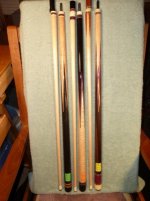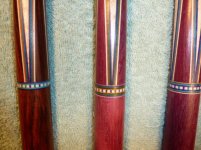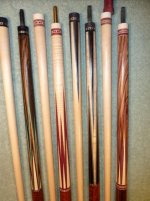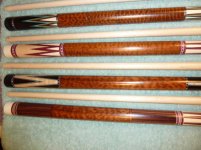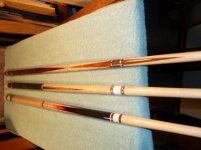You are using an out of date browser. It may not display this or other websites correctly.
You should upgrade or use an alternative browser.
You should upgrade or use an alternative browser.
full and half splice
- Thread starter J Soto
- Start date
I have a cue anatomy page on my website that might serve as a visual reference.
http://lpcustomcue.com/fr_home.cfm
Thanks
Lee
http://lpcustomcue.com/fr_home.cfm
Thanks
Lee
Last edited:
A 'half-splice' isn't really a splice at all. It is inlays that look like a splice. A full splice is actually two separate pieces of wood spliced together using 4 prongs to increase glue surface and adjust weight. A 'half-splice' is a piece of wood for the handle, another for the forearm, and 4 more for the points. The points are inlaid into the forearm, which is then joined to the handle. If you're looking at 8 points, you will most likely be getting inlays. 8 point full splice cues are more labor intensive and difficult to do accurately. I've never attempted one though, so your mileage may vary.
Very good info, rep to ya
A 'half-splice' isn't really a splice at all. It is inlays that look like a splice. A full splice is actually two separate pieces of wood spliced together using 4 prongs to increase glue surface and adjust weight. A 'half-splice' is a piece of wood for the handle, another for the forearm, and 4 more for the points. The points are inlaid into the forearm, which is then joined to the handle. If you're looking at 8 points, you will most likely be getting inlays. 8 point full splice cues are more labor intensive and difficult to do accurately. I've never attempted one though, so your mileage may vary.
Technically, there's a difference between inlaid points & half spliced points. One is a flat piece of material glued into a pocket. Hence the term, "inlay", because that's exactly what it is. The other is the same v-groove cut made on a full splice and square wood glue into it just like a full splice, except the square wood isn't part of the handle wood. Hence the term, "half splice", because it is exactly half of a full splice. There's a fundamental difference & they are named appropriately.
Regardless of the shape of the cavity, it is still an inlay. You remove material to replace it with another for primarily cosmetic reasons. When you splice a tree the tree ends where another is spliced into it. When you do a sheetmetal repair, you remove the damaged material and you splice another into its place. The mechanics of joining a V-groove point blank and a flat-bottomed point blank to the handle are the same but both are different than a full splice. They both require a tenon for attachment to the grip whereas a full splice incorporates the grip in the construction of the blank by being the same piece of wood as the points. Some people don't even differentiate between the two when mentioning 'half-splice' cues. A 'half-splice' is a cue that doesn't actually have a splice. We'll just have to agree to disagree.
Regardless of the shape of the cavity, it is still an inlay. You remove material to replace it with another for primarily cosmetic reasons. When you splice a tree the tree ends where another is spliced into it. When you do a sheetmetal repair, you remove the damaged material and you splice another into its place. The mechanics of joining a V-groove point blank and a flat-bottomed point blank to the handle are the same but both are different than a full splice. They both require a tenon for attachment to the grip whereas a full splice incorporates the grip in the construction of the blank by being the same piece of wood as the points. Some people don't even differentiate between the two when mentioning 'half-splice' cues. A 'half-splice' is a cue that doesn't actually have a splice. We'll just have to agree to disagree.
Cut a full splice in two right at the base of the points. What do you have? You have two pieces. You have the half that is spliced & you have the other half that is just nothing again. Were those points in the spliced half inlaid? Or spliced? So is it an inlay or is it a half splice? It is, with all technicality, half a splice and exactly identical to the component cue makers refer to as half splice.
The OP asked a simple question. He wanted basic definitions of two commonly used terms, so that he could understand what people were referencing when talking cues. Why confuse him? Inlaid points are NOT the same as half spliced points. They are two completely different techniques & give two completely different designs. Both techniques are common in cue making and have terms appropriately appointed to them so one can differentiate. It's common knowledge. So when the OP wanted to know the difference between half splice & full splice, why on Earth would you even introduce and adamantly insist on the term, "inlay"? Inlaid points are a completely & utterly different technique than half & full splicing. Regardless of your own personal feelings about it, we do have common terms already in place & those are what the OP wanted to learn about.
Besides, this forum is called, "Ask the cuemaker". Are you a cue maker? If not, why are you in here answering as one? I'm not trying to be an ass. I just like knowing who i'm speaking with.
Cut a full splice in two right at the base of the points. What do you have? You have two pieces. You have the half that is spliced & you have the other half that is just nothing again. Were those points in the spliced half inlaid? Or spliced? So is it an inlay or is it a half splice? It is, with all technicality, half a splice and exactly identical to the component cue makers refer to as half splice.
The OP asked a simple question. He wanted basic definitions of two commonly used terms, so that he could understand what people were referencing when talking cues. Why confuse him? Inlaid points are NOT the same as half spliced points. They are two completely different techniques & give two completely different designs. Both techniques are common in cue making and have terms appropriately appointed to them so one can differentiate. It's common knowledge. So when the OP wanted to know the difference between half splice & full splice, why on Earth would you even introduce and adamantly insist on the term, "inlay"? Inlaid points are a completely & utterly different technique than half & full splicing. Regardless of your own personal feelings about it, we do have common terms already in place & those are what the OP wanted to learn about.
Besides, this forum is called, "Ask the cuemaker". Are you a cue maker? If not, why are you in here answering as one? I'm not trying to be an ass. I just like knowing who i'm speaking with.
OMG you are starting to sound like Arnot! I like the sound personally.
OMG you are starting to sound like Arnot! I like the sound personally.
Just tired of the BS, Arnie. It's my time of the month I guess LOL
Eric Wynne
Banned
Regardless of the shape of the cavity, it is still an inlay. You remove material to replace it with another for primarily cosmetic reasons. When you splice a tree the tree ends where another is spliced into it. When you do a sheetmetal repair, you remove the damaged material and you splice another into its place. The mechanics of joining a V-groove point blank and a flat-bottomed point blank to the handle are the same but both are different than a full splice. They both require a tenon for attachment to the grip whereas a full splice incorporates the grip in the construction of the blank by being the same piece of wood as the points. Some people don't even differentiate between the two when mentioning 'half-splice' cues. A 'half-splice' is a cue that doesn't actually have a splice. We'll just have to agree to disagree.
What you're saying may be true, but if you took a full spliced cue and cut it in half at the bottom of the points, you'd have the exact same thing as what's called a "half splice". This to me makes the name appropriate.
V-point is what most people use. I never liked the term "half splice", and figure they're a lot closer to an inlay than a splice. When I think splice, I imagine two parts mating up.
Thank you very much. If you cut a full splice in half, it isn't spliced anymore. It is joined with a tenon.
Thank you very much. If you cut a full splice in half, it isn't spliced anymore. It is joined with a tenon.
What if you cut a V at the bottom and joined that to the v-routed handle ?
By definition, if it isn't a full splice, it isn't a splice, and therefore shouldn't even be called a half-splice. If it isn't spliced, it is inlaid, regardless of the shape of the cavity. An inlay requires removal of material and another piece laid into the cavity. That's my opinion. Yours may vary. I simply tried to answer a question that seemed to be ignored by everyone else. I am a novice cue maker, but I've been doing research for decades and have finally made the plunge. I have education in metal, composite, and wooden structures, proper use of adhesives, and use of wood and metal lathes. I may be new to cue making, but I'm not completely unversed to the processes. I'm sorry if I stepped on someone's toes, but I was simply answering an ignored question and then defending my answer.
Last edited:
Okay, I'm not a cue builder, but a longstanding consumer...I think there's a big difference between inlaid points (i.e. flat inlays laid into a shallow flat cavity via a pantograph or cnc) and "half splice" points that are laid into a 90 degree v groove with or without veneers and glued into place--even if they don't naturally come together at the foot of the nose like a full splice. The big difference is that the surface area of two types of wood and epoxy is the same as a full splice, so the forearm is almost the same, whereas the forearm of a cnc'd points cue is for all intents and purposes the same as a merry widow in terms of the structure. I completely get the difference between a full splice and a half splice (where the handle is attached via a v splice or an A joint)...but to say a half splice is the same thing as a pantograph inlaid forearm is not accurate...and we consumers appreciate the difference no matter what you call it.
What if you cut a V at the bottom and joined that to the v-routed handle ?
I guess you'd have to come up with a whole new name?
I guess you'd have to come up with a whole new name?
I believe that's what John Davis frequently does and calls it a full splice. I don't see the big hub bub over the difference between what full & half spliced cues are or what they are called. Half spliced cues still have a full splice below, it's in the form of a tennon which usually also has a bolt or something that provides a mechanical bond as well as the adhesives.
Thank you very much. If you cut a full splice in half, it isn't spliced anymore. It is joined with a tenon.
Amen, that's the point...(no pun intended) Once it's cut in half it's no longer a full splice.
I hate when people use buzz words to confuse...
Cheers to you Lex...
